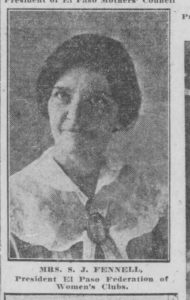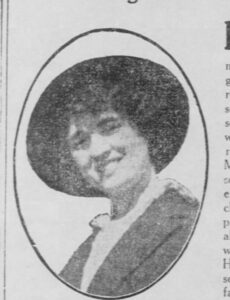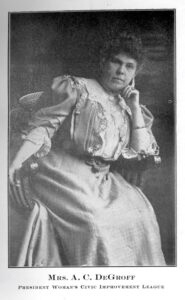The El Paso Equal Franchise League, 1915-1920
By
Joseph Longo
El Paso’s first women’s suffrage group, the Equal Franchise League, was organized at the Hotel Orndorff on January 12, 1915.[1] One of the early members, Helen Freudenthal explained that she became interested in the cause after attending a suffrage meeting in New York and that she was disappointed that there was no league in El Paso. Mary Hammett, wife of El Paso mayor, Benjamin F. Hammett could not attend the meeting but sent a telegram that read, “I wish to be enrolled as a member for the women at this meeting are making history and I want to be one of them.[2] Mrs. George Ullrick was elected a temporary chair at the first meeting and Miss Ruth Augar was elected recording secretary. A letter was read from the president of the Texas Woman’s Suffrage League urging the new chapter to support a legislative amendment that would put female suffrage to a statewide vote.[3] Prior to that first meeting, perhaps to ease concerns that the movement was too radical, the El Paso Herald reported, “The league is not to be a militant trouble maker, it is announced, but the purpose behind its organization is to unite the women of the city who are interested, to study the suffrage movement and to prepare themselves for the time when these women believe Texas will give them the right to vote.”[4] Alzina Orndorff DeGroff, a prominent local businesswoman, became the league’s first president, as the organization elected its initial slate of officers in early February.[5]
Ruth Monro Augur served as third Vice President and as a secretary in the early months of the El Paso Equal Franchise League. Augur was employed as the society editor for both the El Paso Herald and the El Paso Times, where she was able to promote the league’s activities. Augur was also the registrar for the College of Mines and Metallurgy (now UTEP) and designed the school’s first seal. She promoted opening the college to women and Ruth Brown and Grace Odell became the first female students in 1917. In 1916, Augur served as the first president of the El Paso Chapter of the American Association of Business and Professional Women. She went on to become a nationally recognized artist, heading an art gallery in Oklahoma and painted a large mural at an Oklahoma county courthouse during the New Deal.[6]
Initial discussions about a suffrage organization began in 1914 when a group including Augur and ten other women met at the home of Mrs. John Cooke on Fort Bliss. The women discussed how suffrage could be used to improve the welfare of children and women in the community. This mirrored the actions in other regions that allowed the female franchise in local and school board elections because women were seen as municipal housekeepers, their innate morality being the key to social reform. Despite their interest in reform, the El Paso organizers did not see themselves as radicals, criticizing the suffragists in the United Kingdom as militants, arguing that “safe, conservative methods of winning their goal should be followed.”[7] This meeting led to the formation of the Equal Franchise League two months later.
In 1899 Alzina Orndorff DeGroff came to El Paso with her family to purchase the Vendome Hotel located downtown. In 1901 DeGroff reopened the business as the Hotel Orndorff. DeGroff was also responsible for the famous Hotel Cortez, the building still stands at 300 North Mesa Street, the location of the original Hotel Orndorff. Her words from that original January 12th meeting were still remembered at a memorial celebration of her life in 1926. “The time is ready for such a league and we will receive it gladly and in the right spirit. The time has long past since such a step is subject to ridicule. I am sure the league will be a power for good in the community.”[8] DeGroff and other members of the league argued that the organization would not be involved in political campaigns or elections because its first objective was to push for suffrage through education and public awareness. The league’s campaign which included public meetings, rallies, publications and supporting other women’s organizations increased membership.[9]
Within a month, the league boasted one hundred and five members.[10] Soon after the El Paso Equal Franchise League joined the state association (Texas Woman Suffrage Association), founded in 1903 and affiliated with the National American Woman Suffrage Association.[11] Dues were collected at the March 4, 1915 meeting. “The dues were fixed at 50 cents per member annually to enable the league to immediately affiliate with the state suffrage league. In order to affiliate with the state organization, 25 cents per year for each paid-up member must be sent to the state organization.”[12] Like other groups of its kind, the El Paso Equal Franchise League studied the place of women’s suffrage within the nation. Following in the tradition of other women’s advocacy clubs beginning in the 1830s with anti-slavery activism, league women would write, read, and debate papers concerning the franchise for women. Their first objective was to educate themselves and acquire the knowledge they needed to conduct a vigorous campaign for the passage of women’s suffrage. They also sought to spread awareness of the issue by opening the league meetings to the public and by sponsoring events such as a screening of the pro-woman’s suffrage film, “Your Girl and Mine (1914),” which was contracted by the National American Woman Suffrage Association.[13] The screening took place on April 25, 1915, at the Alhambra Theater in downtown El Paso. The league’s educational efforts continued a month later with a public debate at the El Paso County Courthouse. On May 18, 1915, Dr. Paul McCombs and C. C. Young argued for women’s suffrage while Gunther Lessing and Ralf Border spoke against the proposition. A day later the El Paso Herald reported, “Equal suffrage came out triumphant by a small margin, Tuesday night, according to the vote of the audience following the debate….”[14] As the membership matured and its leadership changed, members decided they needed to take a more active role in El Paso and do more than just talk about suffrage.
In September 1915, founding league president Alzina Orndorff DeGroff resigned and was succeeded by Fannie Fennell. As president, Fennell led studies in parliamentary procedure and held parliamentary drills at the league meetings. She also believed the league needed to take a more active role in the community and that the organization’s policy of education was not enough. While reviewing the league’s first year of activities, Fennell stated:
The first year of the organization was a difficult one, for to be seen wearing the suffrage button, or to acknowledge being a suffragette was met by the average person with a smile of amusement or a hoot of derision. Then, too, on every side members were greeted with the question, what are you doing for El Paso? What does the Franchise League mean to the city, anyway? It was not enough that the members were taking up the study of government, were having splendid suffrage programs, were gaining strong members and keeping in touch and helping the state work all that a small and weak organization could. Speeches and debates by some of El Paso’s prominent men were not enough. Why don’t you do something was the cry.[15]
League members recognized the need to do more to open the hearts and minds of El Paso residents. An increased community presence was seen as one way to improve visibility, enhance the reputation of suffragists, and to perform genuine good works in El Paso. They expanded their activities to include helping with particular projects and other movements in the city. Fennell believed that all El Paso women’s organizations, including the league, should work together to improve the community. Starting in October 1915, under Fennell’s leadership, the league led efforts that organized the coalition of twenty-one women’s clubs whose goal was to work together to bring about civic improvement and to build a joint clubhouse. During Fennell’s presidency, the league fundraised and collected clothing donations for the Baby’s Sanitarium in Cloudcroft, New Mexico. The Sanitarium was established as a place to take sick babies who did not fare well in the El Paso climate. The league raised money for the sanitarium by publishing and selling a series of cookbooks featuring German, Scottish, Mexican, American and French recipes. Additionally, the league did its part for the war effort during the First World War by collecting donations for care packages to send to soldiers overseas. Grace Virginia Logan, the first corresponding secretary of the league and society editor for the El Paso Times, was a leader in the league’s war relief efforts and led a campaign to provide magazines and other published materials to the U.S. servicemen. The league also coordinated with the Red Cross in other war relief work.[16]

In October of 1915, under Fannie Fennell and the El Paso Equal Franchise League’s leadership the El Paso Federation of Women’s Club was organized.
In January 1917, Fennell stepped down as president of the El Paso Equal Franchise League in part to take significant statewide positions in the Texas Equal Suffrage Association, serving as district chair for the campaign to pass the state suffrage amendment, heading canvassing efforts in twenty-five counties. Fennell was not the only league member to hold positions with the Texas Equal Suffrage Association. Louise Dietrich, a registered nurse, was appointed by as the county chair in charge of canvassing female voters.[17] In a letter to the El Paso Herald-Post columnist, Ann Carroll, Dietrich wrote, “the El Paso Equal Franchise League was an active one. As a member I traveled over Texas to help the cause.”[18]
Fennell was succeeded by Belle Critchett who like Fennell believed that league had done enough studying and was ready for action. The league also wanted to create different sub-leagues around the county. In 1917 they organized a voter league in Ysleta under the direction of Louise Dietrich. That same year the league helped create the Housewives League to address wartime relief issues. Critchett served as their first president. Despite its early prohibition of election work, the league nominated Sarah Mott Rawlings, a teacher, for the El Paso School Board. In 1917, Rawlings was the first woman to run for the board and her campaign was run by members of the league. Despite a vigorous campaign, Rawlings lost. However, in 1918 Fannie McGrady became the first woman to serve of the El Paso school board.
On July 7, 1917, the El Paso Equal Franchise League passed a resolution condemning the picketing of the White House by Alice Paul and the National Woman’s Party. DeGroff, who resigned from the league in 1915, seemed to be more sympathetic towards these tactics. In August 1918 amid the arrests and jailing of Paul and other National Woman’s Party members, Doris Stevens, a leader in the NWP and a friend of DeGroff, wrote her urging her to join the protests. DeGroff responded in a telegraph, “Gladly would I join the next protest demonstration, but my health will not permit. However, I am with you every day and hour and believe it of the greatest importance as a war measure to do everything possible to place the ballot in the hands of every woman in the country.”[19] DeGroff also communicated with Alice Paul and headed the El Paso branch of the National Woman’s Party until her death in 1925.
In 1918 Texas women gained the right to vote in primary elections. In 1920, the work of suffrage women across the nation bore fruit with the ratification of the Nineteenth Amendment on August 18. The El Paso Equal Franchise League reorganized as the El Paso League of Women Voters, with Belle Critchett as president. In 1915 a group of women saw a need for a suffrage league in El Paso. They did not want to light the world on fire but did want their voices heard. They saw suffrage as central to improving their own lives and those of their daughters and granddaughters. These women also believed that suffrage would improve the welfare and quality of life in El Paso and the nation as a whole. Just like one of the original El Paso suffragists said, they were making history.
[1]According to the El Paso Herald, “The names on the charter membership role are: Mesdames Olga Kohlberg, A. P. [Blanche]Averill, J. F. [Nancy Beall] Williams, Horace [Clara] A. Lay, Dr. Anna Reum, S. J. [Helen] Freudenthal, Charles [Alzina] DeGroff, Dr. Alice G. Merchant, Burt Orndorff, I. J. [Bertha]Bush, B. F.[Mary] Hammett, George [Letita] Ullrick, W. S. [Minnie] Tilton, W. J. [Alma] Cox, Erick St. Clair Purdon, W. M. [Mary] Laughlin; Misses, Octavia Barlow, A. Louise Dietrich, Dorothy Morgan, Irene Laughlin, Geraldine Merchant, and Ruth M. Auger. Auxiliary members, Mesdames, Robert Means, Owen Seaman and C. W. Exton. 13 January 1915, 5. The organization left the charter membership open for thirty days and the El Paso Herald 22 January 1915, 6 included more than 25 additional names.
[2] “Organization of a Suffrage League of El Paso Women Desiring the Ballot,” El Paso Herald 13 January 1915, 5.
[3] “Organization,” 5.
[4] “A Varied Program for the Woman’s Club; An Interesting Week for Local Society,” El Paso Herald 9 January 1915, 10.
[5] “El Paso Women Ask for Ballot,” El Paso Herald 5 February 1915, 12.
[6] Donna Ekal, Guillermina Nunez-Mchiri, P.J. Vierra, Laura Fernandez, Ivan Chavarria, Kaelin Walker, 100 Years of Women at UTEP; 1916-2016 (University of Teas at El Paso Women’s and Gender Studies, 2017), 5.
[7] “Army Women Plan Suffrage League with Cooperation of El Paso Women,” The El Paso Herald 9 November 1914, 5.
[8] “Remember Address Mrs. DeGroff Made 10 Years Ago,” El Paso Herald 12 August 1926, 1.
[9] “Remember,” 1.
[10] New members included, “mesdames W. W. Fink, James G. McNary, Joshua A. Reynolds, C. E. Kellogg, J. F. Kilburn, Parvin Witte, A. F. Sievers, Mary Williams, L. K. Underhill, J. A. Rawlings, Martin A. Wells, M. W. Stanton, Eugenia Seddon, E. Brooks.” “The El Paso Equal Franchise League,” El Paso Herald 12 February 1915, 12. Additional newspaper coverage of the league reveal other women participated in the club including Belle Christie Critchett, Ada Lane Lorenzen, who served as the president of the El Paso Women’s Club, Edith Lane, president of the El Paso Sunshine Nursery, Dora Carter, Dr. Ida Bishop, Dr. Mattie Hill, Rafaela Chisholm, Frances Dudley (wife of Mayor R. M. Dudley), Abby Thomason (wife of Congressman, R. E. Thomason), Mrs. L. T. Kibler, Laurita Ferguson Webb, Jessie McDonald, Mae Loeser, Margaret Olive Jordan (a nationally known author), Julia Sharp, Ruth Taylor, Laura Ferguson, Marie Bonorden, and Mrs. Mundy. The final additions to the charter membership roll before it was closed included, “messrs J. A. Gallagher, Robert Campbell, Burt Orndorff, George Ulrick, Mesdames J. J. Pearce, William McSain, M. W. Redding, D. D. Burwell, H. W. Austin, E. E. Slaughter, Edith C. Lane, J. F. Hammer, Martha Marlan Phelan, Dr. Mattie J Hill, Miss Gertrude Yale, Miss Helen Oldam, and Miss Cora Beale Key.” “Women’s Organizations,” El Paso Herald, 05 March 1915.
[11] At a December 1903 convention held in Houston, the Texas Woman Suffrage Association was founded. At the 1916 state convention held in Dallas, the organization adopted a new constitution and changed their name to the Texas Equal Suffrage Association. A. Elizabeth Taylor, “Introduction and Essay,” in Citizens at Last: The Woman’s Suffrage Movement in Texas, Ruthe Wingarten and Judith N. McArthur, eds. (Austin: Ellen C. Temple, Publisher, 1987) 25, 28.
[12] “Women’s Organizations,” El Paso Herald 05 March 1915, 6.
[13] NAWSA explained that the production of the film “‘boldly carried its propaganda into the moving picture,’ booking engagements for the film around the country with speakers at every stop.” Shelley Stamp, Movie Struck Girls: Women and Motion Picture Culture after the Nickelodeon. (Princeton: Princeton University Press, 2000) 154.
[14] “Suffrage Champions Win Debate; Women Cheer all the Speakers,” El Paso Herald, 19 May 1915.
[15] Fannie Fennell. “Suffrage Work Gains Strength,” El Paso Herald 26 August 1916, 6.
[16] Fannie Fennell, “Suffrage Work Gains Strength,” El Paso Herald 26 August 1916, 6, “El Paso Woman’s Club has New $22,000 Home and 300 members,” El Paso Herald 26 August 1916, 6.
[17] Mrs. O.A. Critchett, “Women of El Paso Want Place in the Sun, Earned by Years of Faithful Effort.” El Paso Herald 1 February 1919, 26.
[18] Ann Carroll, “Dear Ann Carroll: Women Better Do More with Right to Vote.” El Paso Herald-Post 5 October 1961, 24.
[19] Dorothy B. Johnson, “Give Woman Ballot, Curb Polygamists Says Mrs. DeGroff, Invited to Go to Jail for Cause; Would if Healthy.” The El Paso Herald 22 August 1918, 1.


